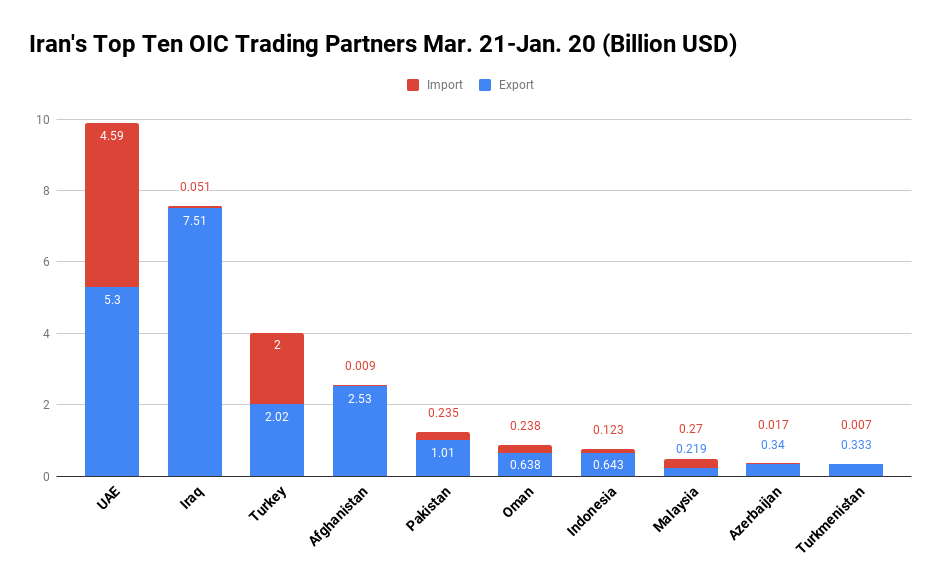Latest data released by the Islamic Republic of Iran Customs Administration show Iran’s exports totaled 54.89 million tons worth $21.86 billion during the period, indicating a 14.49% and 20.39% increase in tonnage and value respectively year-on-year.
Imports stood at 4.23 million tons worth $7.76 billion, down 28.46% and 27.34% in tonnage and value respectively YOY.
Founded in 1969, the Organization of Islamic Cooperation is an international organization consisting of 57 member states, including Iran, with 47 countries being Muslim majority countries. Some, especially in West Africa, have large Muslim populations but are not necessarily Muslim majority countries, according to Financial Tribune.
The organization vows to safeguard the interests of the Muslim world in the spirit of promoting international peace and harmony. The collective population of OIC member states is over 1.9 billion as of 2018.
Since Syria was suspended from the organization in August 2012, it was not included in this report.
Main Commodities, Trading Partners
Iran mainly exported liquefied natural gas, gas condensates, low-density oils, mineral oils, gas, and bitumen to OIC member states.
In exchange, major commodities imported into Iran from OIC nations included cellphones, cooking bananas, steam turbines’ parts, semi-milled rice, wholly-milled rice, boneless frozen cow parts and butter.

In terms of total trade value, the UAE topped the list among OIC countries with Iran trade standing at 15.48 million tons worth $10.76 billion, down by 23.35% and 18.92% in tonnage and value respectively YOY.
Exports to UAE amounted to 12.17 million tons worth $5.31 billion to register a 17.91% decline in tonnage and 1.93% rise in value YOY.
The UAE was Iran’s second biggest export destination among OIC members and third in the whole world.
In return, the UAE exported 3.31 million tons of commodities worth $5.45 billion to Iran, down by 38.37% and 32.38% in tonnage and value respectively YOY.
The UAE was the top exporter of goods to Iran among the states and second in the world after China.
Major Iranian commodities exported to the UAE were gas condensates, low-density oils and mineral oils. The country mainly exported cellphones, steam turbines’ parts, boneless frozen cow parts and butter to Iran in return.
Iraq was Iran’s second biggest trading partner among OIC countries during the 10 months, as two-way commercial exchanges stood at 16.81 million tons worth $7.56 billion to register a 52.1% and 43.71% growth in tonnage and value respectively YOY.
Iran exported 16.74 million tons of goods worth $7.51 billion to Iraq, up by 53.02% and 44.75% in tonnage and value respectively YOY.
Iraq was Iran’s top export destination among OIC states and second in the world during the period review.
Iran’s exports to Iraq included natural liquefied gas, natural gas, evaporative coolers and cleaning detergents.
Iran imported 62,626 tons of commodities worth $51.32 million from Iraq, down 41.38% and 30.05% in tonnage and value respectively YOY, a majority of which were machinery, low-density oil, cans and aluminum alloy.
Iraq was the eighth exporter of goods to Iran among countries under review and 39th exporter to Iran in the world.
Turkey was Iran’s third major trading partner among OIC states.
Trade between Iran and Turkey amounted to 7.2 million tons worth $4.06 billion, indicating a 28.91% increase in tonnage and 6.34% decrease in value YOY.
Iran’s exports reached 6.2 million tons worth $2.02 billion, up 54.58% and 21.33% in tonnage and value respectively YOY, while Turkey’s exports to Iran reached 1 million tons worth $2.03 billion, down by 36.33% and 23.65% in tonnage and value respectively YOY.
Turkey was Iran’s fourth export destination as well as the second exporter of goods to Iran among OIC members. The country was Iran’s fifth export destination and third exporter to Iran in the world.
Natural liquefied gas, non-alloy zinc, aluminum and bitumen were Iran’s main goods exported to Turkey, while the latter mainly exported cooking bananas, tobacco and transmission devices.
Afghanistan was Iran’s third biggest export destination, after Iraq and the UAE, among OIC countries and fourth in the world, as Iran exported 4.82 million tons worth $2.53 billion to Afghanistan during the 10-month period, up by 1.08% and 12.24% in tonnage and value respectively YOY.
Iran mainly exported low-density oils, floorings and iron/steel bars to Afghanistan.
Malaysia was the third major exporter of goods to Iran among OIC members, after the UAE and Turkey, during the 10 months while Iran imported 339,495 tons of commodities worth $358.18 million from Malaysia, indicating a 6.20% and 12.52% decline in tonnage and value respectively YOY.
Iran mainly imported palm oil, machinery and rubber from Malaysia. The latter was the 19th exporter of goods to Iran in the 10 months at the international level.
Highest Growth, Decline in Trade
Trade with Morocco (at $33.76 million), Maldives (at $149,650) and Burkina Faso (at $441,639) saw the highest YOY growths of 233.82%, 222.77% and 163.59% respectively, while trade with Togo (at $2.29), Guinea (at $182,513) and Mauritania (at $113,856 million) witnessed the lowest decline of 95.94%, 88.88% and 86.39% respectively.
Iran’s exports to Morocco (at $32.91 million), Maldives (at $149,650) and Burkina Faso (at $441,639 million) saw the highest growth of 277.35%, 222.77% and 163.59% respectively, while exports to Togo (at $2.29), Guinea (at $182,513) and Saudi Arabia (at $109,063) witnessed the highest decline of 95.94%, 88.88% and 86.53% respectively.
Imports from Algeria (at $300), Uganda (at $371,043) and Oman (at $238.07 million) saw the highest growth of 1,775%, 328.71% and 319.99% respectively while imports from Saudi Arabia (at $251,334), Bahrain (at $812,013) and Qatar (at $7.17 million) witnessed the highest decline of 82%, 68.04% and 67.07% respectively.


